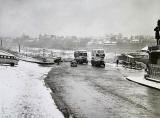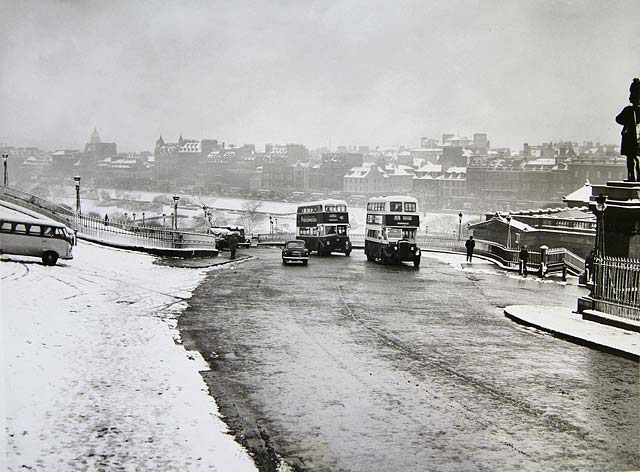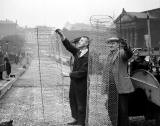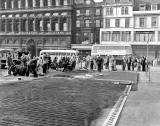|
Street Lighting The Mound |
|
Photo Please scroll down this page to see a photograph looking down the Mound, probably around1959 or 1960, followed by some of the email correspondence that this photo provoked |
||
|
|
||
|
Replies |
||
| 1 |
David King |
Tram Tracks used up to Nov 1956 Electric Blanket - installed > 1956 |
| 2 |
John Cavanagh |
Electric Blanket - installed > 1956 |
| 3 |
Mike Cheyne |
Electric Blanket - installed 1959 |
| 4 |
John Gray |
Electric Blanket - working |
| 5 |
Ian Taylor |
Electric Blanket - installed 1959 |
| 6 |
Stuart Montgomery |
Electric Blanket - installed late-1950s? Electric Blanket - installed 1946? Electric Blanket - installed 1960s? |
| 7 |
Brian Alexander |
Electric Blanket - installed late-1955? |
| 8 |
Joyce Lamont Messer |
Electric Blanket on the Mound Electric Blankets for Homes Departure from Edinburgh |
| 9 |
Peter Stubbs |
Electric Blanket |
| 10 |
Peter Stubbs |
Electric Blanket |
| 10 |
Peter Stubbs |
Electric Blanket |
| 10 |
Peter Stubbs |
Electric Blanket |
©
Any reproduction requires
prior permission of Edinburgh City Archives
Photo from Edinburgh Street Lighting Collection SL/90/8.
Photo Ref. AG
Ingram B897/2
|
Photo |
|
|
Street Lighting Collection This photo comes from the Edinburgh Street Lighting Collection held by Edinburgh City Archive. There are no tall lamp posts in this photo as there are in this photo taken from the foot of The Mound: There are just the low lanterns on either side of The Mound and round the corner into Mound Place. (These lanterns ca still be found today, 2011, on The Mound and the south side of Princes Street where it borders with Princes Street Gardens. |
|
|
Date of Photo The tram tracks have been lifted from this part of The Mound. - The first bus is Reg No GSG13, a Metro-Cammell bodied Daimler** on service 23 to Morningside
- The second bus is Reg No LWS548, one of a large batch of Leylands bought in the mid-1950s to replace the trams. Looking at the traffic in this photo, I feel that it might have been taken some time around the late-1950s or 1960. |
|
Reply 1. David King Trinity, Edinburgh |
|
|
Thank you to David King who wrote: |
|
|
Tram Lines "I think you are probably right about the date of this photo (around 1960). The tram lines on the Mound were used right up to November 1956 by the last two service, 23 and 28."
Electric Heating "Not only were the tracks on the Mound lifted, but the whole road surface was removed. Electric heating elements were installed below the new surface, as there were apparently concerns that the buses might not be able to operate in snow. There was a temperature sensor fixed to a lighting column on the west side of the street, near the Princes Street junction. I donít know if it turned on the elements automatically or alerted staff. The picture above shows that the heating elements were quite effective. Over the years they gradually failed, sometimes giving a patchwork effect in snow, and I think the whole thing is now out of use. Maybe someone else has more information!" David King, Trinity, Edinburgh: January 27, 2011 |
|
Reply 2. John Cavanagh Durham, County Durham, England |
|
Thank you to John Cavanagh who also remembers the electric blanket on the Mound. John wrote: |
|
Electric Blanket "I couldn't help but notice the lack of snow on the road in this photo. I'm sure I can remember reading that when the tram lines were removed and the road re-laid an 'electric blanket' under road heating system was laid down to enable vehicles to climb the Mound during icy weather." John Cavanagh, Durham, County Durham, England: January 27, 2011 |
|
Reply 3. Mike Cheyne Newcastle-upon-Tyne, Northumberland, England |
|
Thank you to Mike Cheyne for posting a message in the EdinPhoto guest book. Mike wrote: |
|
Electric Heating 1959 "Could your photograph of the Mound have been taken in 1959 or later? That was the year they laid miles of electric wiring under the road surface to prevent icing in winter. The road looks as if it has been thoroughly de-iced."
Mike Cheyne, Newcastle-upon-Tyne, Northumberland, England |
|
Reply 4. John Gray Stenhouse, Edinburgh |
|
Thank you to John Gray who also referred to the electric blanket on the Mound. John wrote: |
|
The Mound "It seems to me that the 'electric blanket' on the Mound must still have been working, due to the complete lack of snow on the road surface. Maybe that will help to date the picture more accurately. " John Gray, Stenhouse, Edinburgh: January 27, 2011 |
|
Reply 5. Ian Taylor South Glasgow, Scotland |
|
Thank you to John Gray who also referred to the electric blanket on the Mound. Ian wrote: |
|
The Mound "As far as I can gather, the tram tracks were being lifted in 1958 and an 'electric blanket' to keep the road free of ice and snow was laid in 1959. This device had some faults and was switched off after a few years, but I think it has been improved/replaced and now works efficiently. Perhaps an Edinburgh resident could confirm this." Ian Taylor: South Glasgow, Scotland: January 28, 2011 |
|
Reply 6. Stuart Montgomery Edinburgh |
|
'Electric Blanket' on the Mound Stuart Montgomery has posted his November 2010 photo, looking down the Mound on Flickr. This photo was taken following a fall of about six inches of snow across Edinburgh. The photo is followed by discussion of when the 'electric blanket' - wire mesh that could be electrically heated - was installed under the tarmac on the Mound, and how many years it operated for. One contributor to the Flickr page (georgeupstairs) wrote in November 2010: Date of Installation "In October 1956, the council launched electrically operated dust carts instead of the hand-pushed ones, and three years later an 'electric blanket' was laid under the tarmac on The Mound. The stretch of road there was deemed too hazardous for drivers, so engineers came up with a scheme that used heated mesh to warm up the road and thaw the ice. Their idea proved less than satisfactory though, and was unplugged a few years later." Source: Sarah Howden, Edinburgh Evening News, 09 August 2008 Late-1950s? The paragraphs above suggest that the blanket might have been installed around the late-1950s. This would be consistent with the date assumed for the photo at the top of this page, if the photo is an illustration of a newly installed blanket in operation as may be the case.
The Mound Around 1946? However, the Flickr page above also includes a link to a National Library of Scotland page that gives details of Scottish Screen Archive film Ref No 5854. The film is black and white and silent, lasting 5.46 mins. TITLE: Road Heating - The Mound DESCRIPTION: The laying of cables below the road surface of the Mound in Edinburgh, and the official opening ceremony. DATE: 1946. 1960 I moved to Edinburgh in 1963. Some time during my first few years here, I remember reading in the Evening News about an 'electric blanket' being installed on the Mound. Might this have been the re-installation of an earlier scheme that had not worked satisfactorily? Peter Stubbs, Edinburgh: October 26, 2012 |
|
'Electric Blanket' on the Mound Stuart Montgomery has posted his November 2010 photo, looking down the Mound on Flickr. This photo was taken following a fall of about six inches of snow across Edinburgh. The photo is followed by discussion of when the 'electric blanket' - wire mesh that could be electrically heated - was installed under the tarmac on the Mound, and how many years it operated for. One contributor to the Flickr page (georgeupstairs) wrote in November 2010: "In October 1956, the council launched electrically operated dust carts instead of the hand-pushed ones, and three years later an 'electric blanket' was laid under the tarmac on The Mound. The stretch of road there was deemed too hazardous for drivers, so engineers came up with a scheme that used heated mesh to warm up the road and thaw the ice. Their idea proved less than satisfactory though, and was unplugged a few years later." Source: Sarah Howden, Edinburgh Evening News, 09 August 2008 |
|
Late-1950s The paragraphs above suggest that the blanket might have been installed around the late-1950s. This would be consistent with the date assumed for the photo at the top of this page, if the photo is an illustration of a newly installed blanket in operation as may be the case.
The Mound 1946 However, the Flickr page above also includes a link to a National Library of Scotland page that gives details of Scottish Screen Archive film Ref No 5854. The film is black and white and silent, lasting 5.46 mins. TITLE: Road Heating - The Mound DESCRIPTION: The laying of cables below the road surface of the Mound in Edinburgh, and the official opening ceremony. DATE: 1946. 1960s I moved to Edinburgh in 1963. Some time during my first few years here, I remember reading in the Evening News about work on an 'electric blanket' on the Mound. On reflection, I think the articles might have been about whether or not remedial work should be undertaken to get the electric blanket working satisfactorily again. Peter Stubbs, Edinburgh: October 26, 2012 |
|
Questions So, that leaves a couple of questions: 1. When was the Mound's 'Electric Blanket' installed? 2. For how many winters was it in use. Can anybody help to answer these questions? Peter Stubbs, Edinburgh: October 26, 2012 |
|
Reply 7. Brian Alexander Prestonfield, Edinburgh |
|
|
Thank you to Brian Alexander for telling me about two photos of the installation of the electric blanket on the Mound. |
|
|
Brian wrote: Installation of 'Electric Blanket' "I came across the two attached photos of the 'Electric Blanket' under the road surface on the Mound. They are from the Scran website." 12 February 1955 23 September 1955 "The dates given above these thumbnail photos are the dates of publication as given by Scran, but dates on Scran can be a bit inaccurate." [Agreed. See Reply 10 below! Peter Stubbs] Brian Alexander, Prestonfield, Edinburgh: October 27, 2012
|
|
|
Scran Dates I agree with Brian's comments about the reliability of dates on Scran, especially for photos provided by Scotsman Publications Ltd. In the past I've found the Picture Library at The Scotsman to be helpful in telling me the true dates of some of their photos on Scran. However, this time, I'll have a look at Edinburgh Central LIbrary, at microfilm copies of The Scotsman and Evening News for the dates quoted by Scran to see if I can find the photos and any accompanying articles in the newspapers.. 1955 When I searched the Scran web site for Mound Electric Blanket, it came up with these seven photos, all from Scotsman Publications Ltd. The Scran site gives the following publication dates for these photos. 1st ROW PHOTOS: 28 Oct 1955, 2 Apr 1968, 6 Aug 1958, 12 Feb 1955 2nd ROW PHOTOS: 13 Jan 1955, 23 Sep 1955, 1 Dec 1955 So it certainly looks as if there was activity installing the electric blanket during 1955, if the Scran dates are to be believed. Update See Reply 9 below to read more about the dates of these photos. (The Scran dates should not be believed!) Peter Stubbs, Edinburgh: October 28, 2012 |
|
Reply 8. Joyce Lamont Messer Whanganui, North Island, New Zealand
|
|
Thank you to Joyce Lamont Messer who wrote: |
|
Electric Blanket "I think the first Mound electric blanket must have been in the late-1940s or early-1950s (rather than late-1950s - unless there were 2 versions which I vaguely think there were). I remember my mother pouring scorn on the idea of a blanket for the Mound thinking the city fathers had gone completely mad, though in fact the idea proved to be quite effective."
Electric Blankets "In the late-1940s and early-1950s, electric blankets were expensive and few people had them for their beds, never mind for roads. I had an aunt who made them in her spare time - she did the accounts for an electrician, worked out how they were made and using old blankets to trap the wires, produced them for the family. My mother was dubious and my father was convinced she was trying to electrocute us all. They had no heat control switch. However, if you only used them to heat the bed, kept an eye on them then switched them off and removed them from the bed they were fine and a blessing in the freezing bedrooms of an Edinburgh winter. My parents were soon addicted to Auntie May's electric blankets." Departure from Edinburgh "I left Edinburgh in 1956 - and this was well before that date. I seem to remember the trams had problems getting up the Mound in freezing conditions, not just the buses." Joyce Lamont Messer, Whanganui, North Island, New Zealand: October 28, 2012 |
|
Reply 9. Peter Stubbs Edinburgh |
|
What were the Dates of these Photos? I visited Edinburgh Central Library today to look at the old microfilm copies of the Evening News and Scotsman, hoping to find some of the photos from the Scan site mentioned at the end of Reply 7 above, and any accompanying captions or articles. e.g.
13 February 1959
24 September 1959 * After spending an hour at the library and not finding any of the photos that I searched for on the appropriate microfilm records, I came home and contacted the Scotsman Library to check if the dates on Scran were correct. Update The Scotsman Library has now provided the correct dates for the two photos above, together with the correct dates for other photos that I asked about. Please see Reply 10 below. Peter Stubbs, Edinburgh: October 29, 2012 |
|
Reply 10. Peter Stubbs Edinburgh |
||||||||||||||||||||||||||||||||||||
|
We Now Know the Dates of some of these Photos? For some reason, the date given on Scran for most of these photos is too early by exactly 4 years and 1 day! This table gives the actual dates and papers of publications for these photos, as advised to me by Scotsman Publications Ltd. So it appears that most of the work to install the electric blanket on the Mound was carried out during 1959
Peter Stubbs, Edinburgh: November 1, 2012 |
||||||||||||||||||||||||||||||||||||
|
Reply 11. Peter Stubbs Edinburgh |
||||||||||
|
Extracts from the Press I've now had chance to look through the old newspapers and have found the captions and articles accompanying several of the photos relating to the electric blanket installed on the Mound. Electric Blanket installed 1959 These captions and articles confirm that the electric blanket on the Mound was installed in 1959. I believe that they also dispel the story that there was an earlier electric blanket installed in the 1940s. I think that story probably resulted from another incorrect date on the SCRAN web site. For how many years did the Electric Blanket work? If I can find an article or caption that accompanied picture 3, that may tell us how successful the electric blanket was and how long it operated for. -------------------------------------------------------------------------------------------------------------------- Numbering as in the table in 'Reply 10' above, we have:
Peter Stubbs, Edinburgh: January 1, 2013 |
|
Reply 12. Patrick Lindsay Perth, Western Australia, Australia |
|
Thank you to Patrick Lindsay, Perth, Western Australia for posting a message in the EdinPhoto guestbook in response to my 'Reply 11' above. Patrick wrote: |
|
Response to 'Reply 11', Para. 3: Electric Blanket Switch Off - When? "If we are looking for dates of the blanket being turned off it is just possible it was still operating in the early 70's I suggest that one way to check when the electric blanket was turned off may be to contact Edinburgh Council Records/ Archives/Minutes Office. I assume they paid the bills and the event would be surely significant and recorded."
Patrick Lindsay, Perth, Western Australia, Australia: |
|
Response to 'Reply 11', Para. 8: Electric Blanket Controls Findlay Irvine Ltd. "Findlay Irvine Ltd of Penicuik made many different products based on their 'Icelert' technology. Icelert was used to give warning of icing on military aircraft runways, railway points heaters and public roadways. The Mound was one of their roadway installations. I worked for Findlay Irvine from '1970 to 1975 as an engineer. Probably around late-1973, I visited the switch room under the Mound with the company's service engineer. The room is in one of the previous photos and is located in the lower side of the mound that faces west. (I think we were making a system calibration and health check before the start of winter) I remember there were three Icelert controllers meaning there were three lots of probes in the road. What I can't remember is if Icelert was controlling the blanket in three sections or just giving aggregate warnings of impending ice formation with, what I seem to remember as, a white flashing warning light on a pole The roadway installation was very similar to the runway version (and was probably designed before the runway version). There were multiple probes for each Icelert controller to work out if it was wet or not and also rate of temperature drop. A bit more info on the runway controls can be found on Google Books Results at: 'New Scientist - 21 Dec 1972, Page 703'."
Patrick Lindsay, Perth, Western Australia, Australia: |




